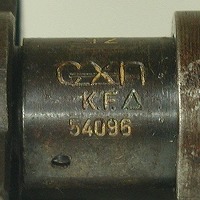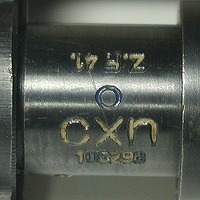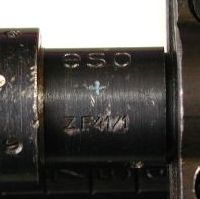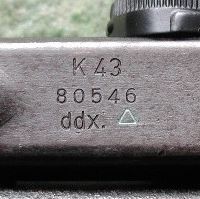Lubricant markings on Optical Instruments
| Special thanks to the members of the "Wehrmacht-Awards.com Militaria
Forums".(KenT) |
Lubricant types
It is known that the Wehrmacht adopted several types of cold-resistant greases according to their inexperience with extraordinary cold-temperature, especially at the Eastern front. They had already begun the improvement before the Russian campaign and continued it throughout the war. Thus, according to the newly adopted cold-resistant grease, new marking was applied on the optical equipments. The marking is as the following.
- "K.F."
The earliest marking seen on optics. It indicates the optic is lubricated
with cold resistant grease "Busch-C-Fett" or newly developed
"Invarol", which is said to be serviceable to -20 degrees C.
According to the "Allgemeine Heeresmitteilungen", these were
were adopted on 27th May 1940.
- "O" (hellblaue Kreisflaeche or light blue circle)
The next marking indicated new cold resistant grease, Vacuum grease (Vakuumfett)
1416, suitable for use under lower temperatures as to -40 degrees C. The
earliest document referring to this "O" is the German manual
for winter warfare "Taschenbuch fuer den Winterkrieg", first
version dated 5th August 1942.
 |
 |
"K.F." on early ZF41 Type1
with Triangle added later |
Blue "O" on ZF41 Type2 |
- "+" (hellblaues Kreuz or light blue cross)
It seems that the Vakuumfett 1416 was somehow turned out to be unsatisfied soon, since on the revised version of the "Taschenbuch fuer den Winterkrieg" dated 1st November 1942, another marking "+" was mentioned. Although there is no explanation for the reason of the adoption, it is said that with the mark the instrument is perfectly serviceable to -40 degrees C and "in Zukunft wird das gesamte Beobachtungs und Vermessungsgeraet des Heeres nur mit Instrumentenfett 1442 gefettet (in the future, all observation and surveying instruments of the Army will be only lubricated with instrument grease 1442)".
- Light blue triangle
Yet, another marking appeared in the late 1943. I have not been able to
find any document referring to the "triangle", the name of the
grease and its suitability. But I have heard it was suitable for use between
-40 degrees C and 50 degrees C.
 |
 |
| Light blue "+" on ZF41/1 |
Light blue Triangle on ZFK43(GwZF4) |
Estimate of the manufactured year
Although the exact date of the grease adoption at the factory could be different by manufacturers, it is clear that they were adopted in this order. The date of the document does not show the exact date of the adoption, but one can assume they are nearby. So this leads me to a very rough estimation of the manufactured date of the optical equipments according to the lubricant markings.
- K.F. : 1940-41
- O : 1942
- + : 1942-43-44 (mainly in 1943)
- Triangle : 1943-44-45 (mainly in 1944)
Another thing to mention. It is known that the marking was often added later when the instrument was repaired or maintained and re-greased. So it is not rare to see optics with double, or more, lubricant markings applied. But if one knows which marking is the earliest and can tell it is original from the factory, he can assume its rough date from my estimation. The study of the other markings on the instruments about its pattern and variation would help this.
The color of the lubricant markings
Peter R. Senich says in his book "The German Sniper 1914-1945"
that the color of the triangle (on GwZF4 scopes) represent the reliable
function limits of each device in various climates. White for normal weather
conditions in central Europe, green for tropical, and blue for extreme
cold weather. But he says nothing about where his information came from,
and I have not been able to find any original source on "white"
and "green". I have a little doubt on those colors since I have
some questions. Why did they have to use three types of lubricant in 1944
when the front was getting nearer to the German border? And why almost
every GwZF4 have blue triangle and not white? Of course, I have heard of
those colors on some optics but those seem to be rare examples. And there is also an opinion that those colors on binoculars have meaning not more than just to highlighten the markings.
Other unknown markings
- "(K)"
Seen on two types of very early ZF41. One is with its manufacturer name
"Busch Rathenow" marked, and on the another type the manufacturer
name is replaced with its manufacturer code "cxn". And it is
always seen as "1,5 x 1,3゚(K)". Richard D. Law presumes in his
book "Backbone of the Wehrmacht Volume II" that the "(K)" stands for "Kaeltefest" but I
am not sure. The "cxn" version has "K.F." marking originally
together.
This "(K)" is not seen on binoculars nor other optics.
- Red "X"
The red "X" is only seen on large Flak binoculars DF 10x80. It
is said that this mark indicates the optic was re-greased to replace the
former "K.F." type. So it seems to be safe to say the red "X"
came after "K.F." and perhaps "O". Still, its relations
with "+" and "triangle" remain unknown. And the type
of lubricant and its suitability, and why it is only seen on 10x80.
Information Needed!!
I don't have enough information yet. If you have any information (or
original documents) on these lubricant markings, please let me know. And
any opinion is greatly appreciated.
|




